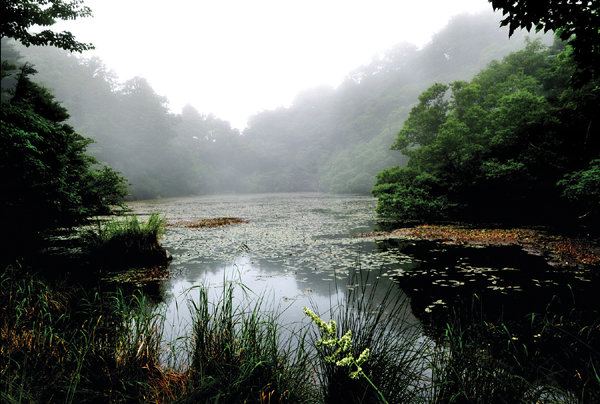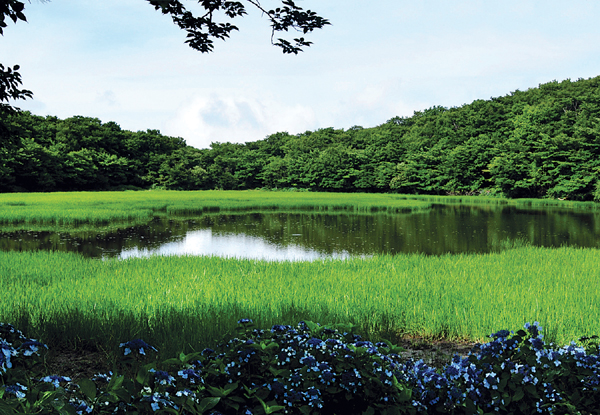
- Updated 2025.1.15 16:26
- All Articles
-
member
icon
-
facebook
cursor
-
twitter
cursor
| |
 |
|
| ▲ Sobaekrok Wetland on Hallasan is another important water-bearing area in Jeju. Such areas are vital to the preservation of flora and fauna, some of which is found only in Jeju. Photo by Ko Young Seok, Jeju Environmental Photography Committee |
Water. When the rainy season hits Jeju it may feel like you could drown just looking up with your mouth open, but in fact water is a scarce resource on the island, particularly for wildlife.
As development continues to swallow up land, more and more pressure is brought to bear on the flora and fauna that depend on Jeju’s wetlands to survive. It’s a competition that without intervention, the plants and animals would surely lose.
Fortunately the Korean government has recognized this peril, and acted to set aside two large tracts of wetland for the preservation of Jeju’s unique ecosystem. The wetland preservation zone designation will be discussed with the Jeju government soon, with an announcement expected by September.
The areas being considered for preservation are the 1100 Highland Wetland and Muljangori Oreum Wetland, which is already an internationally recognized preservation.
The wetland atop the Oreum is actually a 628,000 sq. meter crater lake, and contains several rare and endangered species of flora and fauna, including the Jeju salamander and the Jeju weasel. As their name implies, these are found only in Jeju Island.
The year-round wetland is also home to 35 bird species, with nine of them in the “rare” category, including the Peregrine falcon and Black Paradise flycatcher.
| |
 |
|
| ▲ The crater lake atop Munjangori Oreum is considered an important Jeju wetland, and recently received recognition as such from the international Ramsar Convention. Photo by Ko Sang Yong, Jeju Environmental Photography Committee |
The wetland scored a significant victory in 2006, when it was designated as a Ramsar Wetland Conservation Area. The designation was made at the Tenth Annual Ramsar Convention.
The name comes from the fact that the first convention was held in Ramsar, Iran, in 1971. The environmental organization, officially known as “The Convention on Wetlands of International Importance, Especially as Waterfowl Habitat,” has 158 member countries, with close to 1,800 wetlands worldwide. It is commonly called “The Convention on Wetlands.” Korea has been a member since 1997 and has 11 wetlands on the list. Only one so far is in Jeju.
The Ministry of the Environment also hopes to have the 1100 Highland Wetland listed on the Ramsar Convention by the end of this year.
The wetland is environmentally significant in that it contains many rare plants, such as the Japanese quillwort and utricularia racemosa wallich.
The Muljangori Oreum already enjoys protection due to its proximity to Hallasan, since it is included in the boundaries of the UNESCO World Natural Heritage Site.
There are long-range plans to promote the Oreum as an eco-tour site, with conservation facilities, eco-guides and an eco-tour infrastructure.
|
|
|
|
|
|
|
 Marcie Miller의 다른기사 보기 Marcie Miller의 다른기사 보기 |
|
ⓒ Jeju Weekly 2009 (http://www.jejuweekly.net)
All materials on this site are protected under the Korean Copyright Law and may not be reproduced, distributed, transmitted, displayed, published without the prior consent of Jeju Weekly. |
|
|
|
|
| Jeju-Asia's No.1 for Cruise |
|
|
|
Title:The jeju Weekly(제주위클리) | Mail to editor@jejuweekly.net | Phone: +82-64-724-7776 Fax: +82-64-724-7796
#503, 36-1, Seogwang-ro, Jeju-si, Jeju-do, Korea, 63148
Registration Number: Jeju, Ah01158(제주,아01158) | Date of Registration: November 10,2022 | Publisher&Editor : Hee Tak Ko | Youth policy: Hee Tak Ko
Copyright ⓒ 2009 All materials on this site are protected under the Korean Copyright Law and may not be reproduced, distributed, transmitted, displayed, published
without the prior consent of jeju weekly.com.

|





















